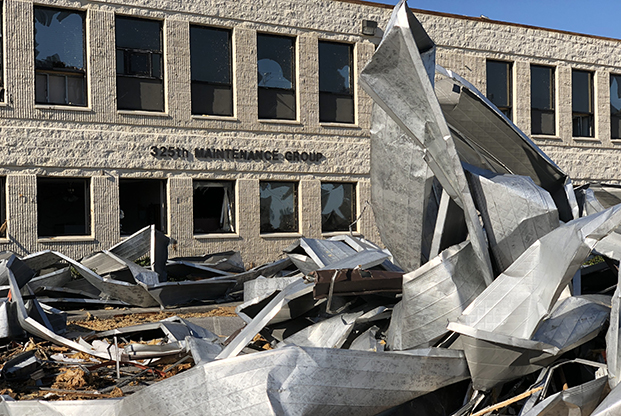
This Oct. 14 photo shows Hurricane Michael's impact on the 325th Maintenance Group's building at Tyndall AFB, Fla. Air Force photo by SSgt. Alexander Henninger.
TYNDALL AFB, Fla.—The commander of the 325th Fighter Wing here was one of about 90 airmen who stayed behind to ride out the storm as Hurricane Michael made its way to shore last month. Col. Brian Laidlaw was holed up inside a conference room with dozens of other airmen for hours as winds reached 155 miles per hour, rattling the walls, ripping up trees, and basically wreaking havoc outside. The rest of the airmen were sheltering on the other side of the base.
Laidlaw told Air Force Magazine during a recent visit to Tyndall that his group got a short reprieve as the eye of the storm passed over the flight line. Everyone walked outside to take pictures, but soon enough the wall came back. This time the powerful wind ripped off the roof above their heads and rain started pouring in, forcing the team to flee to the basement to ride out the rest of the storm.
When the storm eventually ended and the airmen went back outside, Laidlaw said the area, “looked like a warzone.” Every building was damaged. Every tree was ripped in half. The fence line surrounding the base had disappeared. At that moment, the severity of the storm really hit home, and Laidlaw said to himself, “Holy cow, this is a big deal.”
“One of the first things we did was put together a list of who … in the Air Force we could call now to help us get started,” he said. Almost immediately, special tactics airmen from nearby Hurlburt Field, Fla., piled into CV-22 Ospreys to get Tyndall’s flight line running, RED HORSE airmen from Hurlburt arrived to evaluated the infrastructure and build up what was needed to resume initial operations, and a base defense group from Moody AFB, Ga., came to protect the exposed base.
With the recovery effort now underway, about 1,300 airmen are living in a “tent city,” though some are sleeping on cots inside of offfices, as Air Force leaders try to figure out what comes next.
Good afternoon from Tyndall AFB, @TeamTyndall is busy getting more Raptors ready to fly, get the 601st AOC up and running, and getting airmen back to rebuild the base. pic.twitter.com/lA7PH4VZVl
— Brian Everstine (@beverstine) October 30, 2018
More than 95 percent of Tyndall’s structures were damaged, many of which must be demolished. And though the storm’s damage is tragic, it also represents a new beginning for the Air Force.
“I would say, as you look around the base here, there is tremendous opportunity,” Laidlaw said.
Some portions of the base fared well. The “A” and the “C” of the “AFNORTH AOC” sign were ripped off during the storm, but for the most part the 601st Air Operations Center building held up well. The building housing all eight full mission F-22 simulators is in decent condition, and officials expect the F-22 school house to return to operations by the early next year. However, several buildings already have been torn down, including dormitories that were no longer livable.
“We now have real data that shows us what type of structures don’t fare so well in hurricanes, and what types of structures fare much better,” Laidlaw said. “I think we have an opportunity to capture some of those lessons learned.”
The Air Force can use this information to smartly build a next-generation base instead of just rebuilding what existed before. “It’s easy to run around and rebuild the buildings we had on Oct. 9, but that might not be the smartest strategy,” Laidlaw said.
Tyndall is still in the “infancy” stage of the rebuild. Airmen and contractors are evaluating buildings to determine what is salvageable so USAF leaders can decide what missions can return.
Laidlaw said Wednesday he has not “had the time to debrief myself,” but “that’s coming” and “that’s important,” in order for the Air Force to really understand “how prepared” it was. That goes beyond just the integrity of the buildings, USAF also needs to look at its doctrine as well as policy for evacuations, training, and immediate steps following a major storm.
While there were lessons learned from other natural disasters, such as Keesler AFB, Miss., following Hurricane Katrina or Homestead AFB, Fla., following Hurricane Andrew, Laidlaw said those are all “apples to oranges comparisons.” Though there is some knowledge to be gleaned from after action reports, Laidlaw said there is no one way to respond to a storm like this.
“There certainly is not a checklist for how to rebuild a base,” he added.
